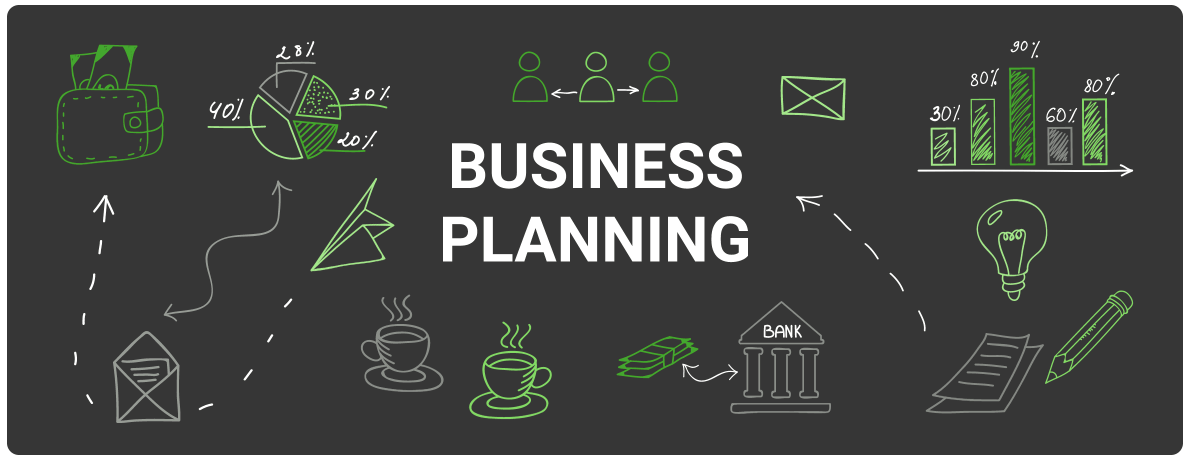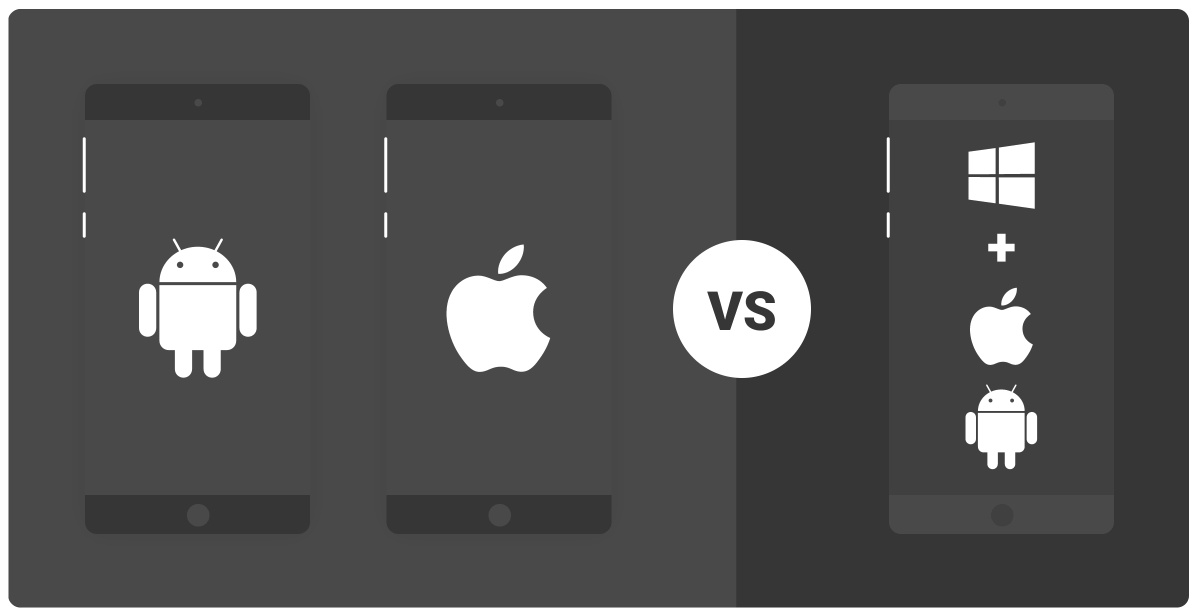The number of smartphone users is growing rapidly every year. As of the latest Statista report, there are 275.66 million users in the US alone in 2020. Thus, a custom mobile app is a great way to do business worldwide at a reasonable cost. But what if you have an idea for an amazing product, but your budget is tight? We've prepared some tips to help you save costs and build an app that will hit to market effectively.
#1 Set Clear Goals and Reasons for your App
Before you start building an application, you need to answer some questions and do some research. Even you already know what your product will look like, that's not enough. You should be able to describe as much as possible about your project.
Determine the Target Audience
The better you understand your potential customer, the more successful your app will be. When you know your users’ exact age, education, hobbies, and even what they eat for breakfast, you will have the opportunity to create a top-notch marketing strategy. For a product to be successful, it must address specific customer needs. And to understand what these needs are, you should thoroughly study your potential user. Remember that the narrower your description, the more effective it will be for marketing.
Make Competitors Analysis
You must also know your competitors perfectly, understand their strengths and weaknesses. Based on their experience, you can make a product with clear advantages. So, study everything about products similar to the one you are planning to create. This includes the technologies used, monetization methods, sales market (perhaps competitors conduct their activities only in certain locations), design, color combinations, marketing strategy, and so on. This information will also help you determine which features are essential for the application and which can be implemented later, saving costs on the first launch.
Here are some questions that can help you get crucial research results:
Who will be using your application?
What are the interests of these users?
What are the important features to them in the application?
What age group should the app target?
Who are your competitors?
What are the focuses of your competitors on their mobile app?
Why should your customers download your application?
What makes your offer unique?
What is the main function of your product?
What results do you expect to achieve within the first 3 months after launching the product on the market?
What results do you expect half a year after the release of the application?
It’s about what you want to achieve. Without a clear vision, you don’t know what goals to set or what actions to take. You need to be exactly clear about what you want.
- Kim Perell, the CEO of Amobee
#2 Create Clear Specifications
Every feature you add to your app will ultimately affect your overall budget. Therefore, before you start custom mobile app development, you should prepare a clear description of the business logic you want to implement. It means that you need to define all the functions that you want your product to have. And next, prepare a detailed description of their characteristics. For example, if your application needs to have a search, then explain what filters it should offer users, whether you want to display any default results, how sorting should be done, and so on. The more detailed your description is, the easier it will be for developers to understand your project.
Chances are, if you want to implement all the features at once, it will cost a lot. So prioritize if your focus is on the low cost of app development. Indicate the tasks that should be completed first—for example, registration, search, and purchase. Less essential functions, such as adding promo codes or using discounts, can be done later. Think about what is important to the user and will attract the most users to the application. And then prioritize based on that data. Your application must be completely user-centered if you want it to be successful even with a limited budget.
Hire reliable developers from KeyUA to create a quality mobile app at an affordable price.
Contact Us#3 Think About Monetization

It's time to decide how your app will generate revenue. It is necessary to determine this before development, as the source code will also depend on it. If you think over such nuances in advance, you will avoid extra costs during the app building process.
In this case, the analysis of competitors you did in the previous step will be useful. Evaluate which app monetization models exist in apps similar to yours. Maybe this will also suit your product. But keep in mind that not all models that enterprises use are suitable for startups.
Top 3 Revenue Models for Fresh Released Apps:
Freemium. The bottom line is that the application is free to download, but the user pays for additional functionality. Dropbox uses this method. The app offers to create a profile and 2 GB of data storage for free. Storage expansion comes at an additional cost.
Subscription. This is a way to generate permanent income. You open access to the application after the user chooses a monthly or annual plan, depending on which model you have developed. It is one of the most popular ways to monetize and is used by both startups and large businesses, for example, Netflix.
Paid download. This is an opportunity to receive income immediately. Users pay a one-time fee to download your app and then use all of its features at no extra price.
#4 Prepare a Business Plan

A business plan is a crucial document for any company. It contains calculations, analysis, and information that shows the viability of the business as a whole. It will also be a prerequisite if you are looking for investors for your project. A business plan describes how you are going to build your company, set your budget, and how you are going to make a profit.
Here are the main reasons why you definitely need a business plan:
It will help drive the growth of your company. Even if you are on a budget, the right business plan will guide you through all the paths of building a successful brand, entering the market, and gaining popularity.
It's actually quite simple. A business plan is created for 3-5 years, and your income is projected. Of course, this is important if you have a limited budget and expect to profit after the application goes to the market. Divide the business plan into mini-plans so that it is more convenient for you to implement.
It will help you get ahead of the competition. A well thought out document allows you to see your strengths and weaknesses. When you are a startup and have someone to compete with, a business plan can be a significant advantage and save you from ruin.
Banks and investors will be more supportive if they see your business plan and the described company development strategy.
#5 Determine the Right Pricing Model
Your next step is to decide what is the most efficient collaboration option for your budget. You need to determine if you want to pay by the hour or contract for a fixed amount.
If you are involved in mobile app development on a tight budget, it seems reasonable to choose a fixed price model. That is, you pay for a month or two, or three of the development, depending on the contract, and the developer must complete the planned volume of tasks within the established deadline. But with this interaction model, you have no opportunity to make changes to the project. That is why it was important to prepare a detailed specification and prioritization in the previous steps.
At the very first stage of development, most customers have wishes, corrections, and important changes that need to be made. This, in turn, affects the development cost. Before signing a contract with a development team or a freelancer, carefully discuss all the interaction details and how you will react in case of necessary changes. Discuss flexible payment options with contractors.
#6 Think of Hybrid Development

When you are developing a mobile application with a small budget, you should define the platform on which it will run. Just do it based on your target audience. According to Statcounter, Apple is used by 24.99% of users worldwide, while it dominates in the US, Canada, and Australia. Android is used by about 75% of users, and this operating system is prevalent in Asia and South America.
At the same time, mobile development exists in the following types: native, cross-platform, and hybrid. Native development is considered the most expensive since it creates different source codes for iOS and Android. Cross-platform app development is more cost-effective as it involves creating one code for two operating systems. In turn, hybrid applications combine the functions of native and cross-platform apps and are perhaps the most affordable option for creating a mobile application with a shoestring budget.
#7 Find Outsourcing Development Team
Treat your search for a technical team with the utmost responsibility. Consider several partnership options. It may be just a freelancer or a team of several specialists. The most optimal solution is to look for outsourcing contractors.
Outsourcing is when you entrust creating a project to third-party contractors instead of hiring appropriate personnel directly into your company. The essential advantage of outsourcing teams is that they are more cost-effective. You will not need to interview developers, accept them into your organization, and manage them. Instead, you can contract with an outsourcing company that will provide you with a team according to your project’s needs. Read more regarding the pros and cons of outsourcing software development.
There is also an opportunity to hire freelancers. Perhaps this is the cheapest way of interaction, but as practice shows, this is also a more risky decision.
Freelancers and outsourcing teams do not have to be in the same city as you. They can be in different countries or even on different continents. And it shouldn't be a problem at all for your interaction with the team. Choose executors who can provide you with complete transparency regarding all stages of the project.
Now let's look at the pricing policy depending on the developer's region. Please note that we are showing the average values. The cost will also be affected by the platform you choose for the product: iOS developers charge a higher fee than Android programmers). Programmers from the United States will ask for the highest fees; they charge $100-150 per hour. Hiring a specialist from the UK will cost you from $55-75 per hour. The hourly rate for Europe is from $30 to $50. When hiring developers from Ukraine, you can expect to pay $30-40 per hour. Programmers from Asia charge $20-30 per hour. Note that low cost can be associated with high risks of getting a substandard product. Thus, carefully interview each company or an individual developer you want to hire.
At KeyUA, we set dedicated teams according to product needs, covering developers, designers, testers, marketers, etc. Our company provides quality services for the development of mobile applications that will suit any budget.
Contact Us#8 Consider Pre-Built Features
Building a mobile app from scratch can be a costly ordeal. But the overall price can be reduced if you use pre-built templates, which can be tweaked in accordance with the requirements of your project and the specifics of the industry. Instead of developing custom functions, you can use third-party APIs. For example, to create a support chat, you can simply integrate the appropriate Google plugin. However, such a release model can slow down the application because it has to access third-party resources.
#9 Start from an MVP Version
Before you release your dream app, take care of creating a minimum viable product (MVP). An application that is created in accordance with these standards will have a minimum required set of functions, attractive to your target audience, which you can use to evaluate your product and even come up with ideas for improving it. In general, creating an MVP is an excellent solution not only in terms of cheap mobile app development but also to discover how appealing the product may be to users. A minimum viable product saves money and frees you from the fear that potential users may ignore the final product. The time required to create the MVP varies depending on the project’s complexity, but on average, it takes from 3 weeks to 2 months.
#10 Keep it Simple, Intuitive, and Unique
When creating your own mobile application, you may feel compelled to add more and more functions to it. This is not the best idea. The clutter of great functionality can cause the application to be slower and more confusing to the user. If you have a limited budget for a mobile app, keep it simple. Instead of developing a vast number of features, focus on the most basic functionality, and do it well. A software with multiple functions that is fast, reliable, and stable has a greater competitive advantage over a feature-rich application that freezes or produces incorrect results.
#11 Choose the Correct Tech Stack
There are lots of technologies for creating mobile applications, and every year more new tools come out. The temptation to choose a trendy package is high, but keep in mind that it will cost more and does not guarantee that you will receive a first-class product. The best way to build a budget app is to use reliable and proven tools. Discuss this question carefully with your development partner, who will be implementing the application source code.
#12 Don’t Forget About Maintenance Costs
The price of maintenance includes any costs associated with supporting the functionality of the application. For example, you want to create an application like Uber that will send text messages to drivers. Of course, many third-party libraries and services allow you to do this for free. But, when developing software, think carefully about whether you may have additional costs associated with the features of the application and how you will cover them. Perhaps you are assuming that they will be paid from future income. However, if you are on a tight budget, it’s better not to take risks and predict all the detailed costs in advance to avoid the unpleasant surprise of large invoices.
Conclusion
The key to success in the development of any software is careful preparation. If you don’t carefully consider the nuances of product implementation and maintenance in advance, you could significantly exceed your budget. One of the main points in building a product is still the choice of partnership. A reliable and experienced team will help you avoid mistakes in designing your application and provide useful recommendations for saving your budget.
At KeyUA, we have iOS and Android developers with 12+ experience in creating applications of varying complexity. We strictly follow the client's budget, avoid cost overruns, and deliver all tasks on time.
Benefit your business with a trusted outsourcing development team from Ukraine.
Contact Us







 Unit 1505 124 City Road, London, United Kingdom, EC1V 2NX
Unit 1505 124 City Road, London, United Kingdom, EC1V 2NX

Comments
Leave a comment